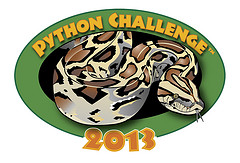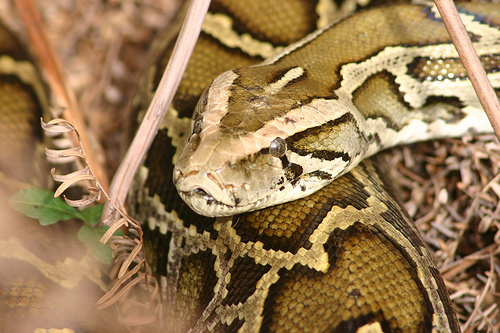Last weekend I heard a story I won’t soon forget. Bob Freer, who runs an animal rescue shelter in the Everglades, appeared on a rerun of Wait Wait Don’t Tell Me, and he began to talk about Florida’s python problem. Of course, I knew Florida had a python problem. But there’s knowing, and then there’s the kind of knowing that can only come from hearing about an encounter.
About 15 years ago, Freer received a call from a homeowner who claimed to have a snake lodged under his home. Freer and his team went to the site and shined a flashlight into the crawlspace to see if they could spot the snake. It was just out of reach, and Freer soon realized that none of the hefty adults he had brought with him would be able to shimmy in to grab it. “But at that time we had a young kid with us, a volunteer,” he told the host. You can see where this is going, right?
They tied a rope to the kid’s feet and armed him with a broom handle wrapped in a towel. “I want you to crawl on your belly in there. And when you get close to the snake just poke the towel at him. And then when the snake bites the towel, you scream, we’ll pull you out,” Freer explained.
I wouldn’t say I’m scared of snakes exactly. But I am claustrophobic. The idea of wedging myself into a barely child-sized space that is also inhabited by a python . . . well, no. I wouldn’t do that. I would refuse. But that kid is braver than I am and he went. They finally extracted the snake. It was 26 feet long and 320 pounds, according to Freer.
 That might be a bit of an exaggeration. A man killed an 18.8-foot python this spring that weighed 128 pounds, and researchers at the University of Florida said that snake was the longest ever recorded. Nearly as long, in fact, as three researchers. The state has some big-ass pythons.
That might be a bit of an exaggeration. A man killed an 18.8-foot python this spring that weighed 128 pounds, and researchers at the University of Florida said that snake was the longest ever recorded. Nearly as long, in fact, as three researchers. The state has some big-ass pythons.
These are Burmese pythons, a native Southeast Asia. No one can say for certain how these snakes entered the Florida Everglades, but it’s likely that irresponsible pet owners dumped them there. Or perhaps they escaped. Either way the snakes thrived. According to herpetologist Michael Dorcas, the pythons were probably breeding in the wild as early as the 1980s. By 2000, the species had firmly established itself. Dorcas estimates there might be tens of thousands of pythons living in southern Florida today. Some estimates suggest there may be more.
That’s troublesome for a couple of reasons. First, these snakes are terrifying. Just this month, authorities captured a 100-pound albino python in a shed. When the shed’s owner found the snake, it was reportedly swallowing a cat skull.
Second — and far more importantly — the pythons appear to be wreaking ecological havoc. Dorcas’ and his colleagues analyzed the number of mammals observed in Everglades National Park during nighttime road surveys. They compared mammal sightings from the 1990s — when the snakes were rare — with sightings from 2003 to 2011 — when the snakes were common [PDF]. The data suggests the pythons are responsible for dramatic declines in raccoons, opossums, foxes, bobcats, and rabbits. The snakes have even been known to take down deer. No one is going to cry over a devoured bunny or two. But if these reptiles are having such dramatic impacts on common mammals, imagine what they’re doing to rare hard-to-spot species, like the endangered Key Largo wood rat.

In fact, the snakes pose such a threat, this year the state held a hunting contest: Python Challenge 2013. The month-long contest attracted nearly 1,600 participants, but had little effect on the python population. The group boasted a harvest of just 68 pythons. The winners, who bagged 24 snakes, took home $1,500 each.
I’m not against hunting. And I’m all for getting rid of pythons in Florida. But this snake-killing jamboree was more spectacle than hunt. The event — with its cartoon logo, exotic species ‘culinary safari,’ and giant snakeskin — had all the trappings of a county fair. Even Senator Bill Nelson joined in the fun. But dispatching snakes is serious business. Euthanizing a python with a bolt gun or firearm or machete is something that should give one pause, not incite revelry.
If killing snakes is the best way to protect Florida’s native species (it may not be), I’m all for it. But let’s leave the job to trained professionals. And let’s not turn a slaughter into a carnival.
I’ll leave you with this thought from the always eloquent Emma Marris: “… these snakes, which are just doing what they evolved to do as they pig out on the native fauna, have been painted as evil and despicable. It’s the blame-the-invasive-species narrative that’s been in fashion for a few decades now, here helped out by the fact that many people have a visceral ick or eek reaction to snakes. But it isn’t the pythons’ fault. It is our fault for introducing them.”
It’s a fact we often forget. We have brought this on ourselves.
**
Photos courtesy of IFAS/UF and Florida Fish and Wildlife

The only thing I can say in response to your comment, “But let’s leave the job to trained professionals.”, is that(from my understanding of the problem)there are not enough trained professionals to control the problem considering how bad the problem has become.
It was the trained professionals that came up with the python challenge as an attempt to ameliorate the situation. I feel that as the public becomes more skilled in hunting pythons, they will have greater success in future python hunting seasons. Researchers are currently investigating techniques to identify and target pythons when they are nesting (with the hope they’ll be able to kill adults and young before they reach reproductive age), but in the meantime, a python hunting season may be one technique that provides some level of control to keep the population in check. Hunting seasons are used in other areas of the country for certain species where no natural predator exists, so why not give it a try with the pythons? Even though the first season wasn’t that successful is not reason enough for me to abandon the project.